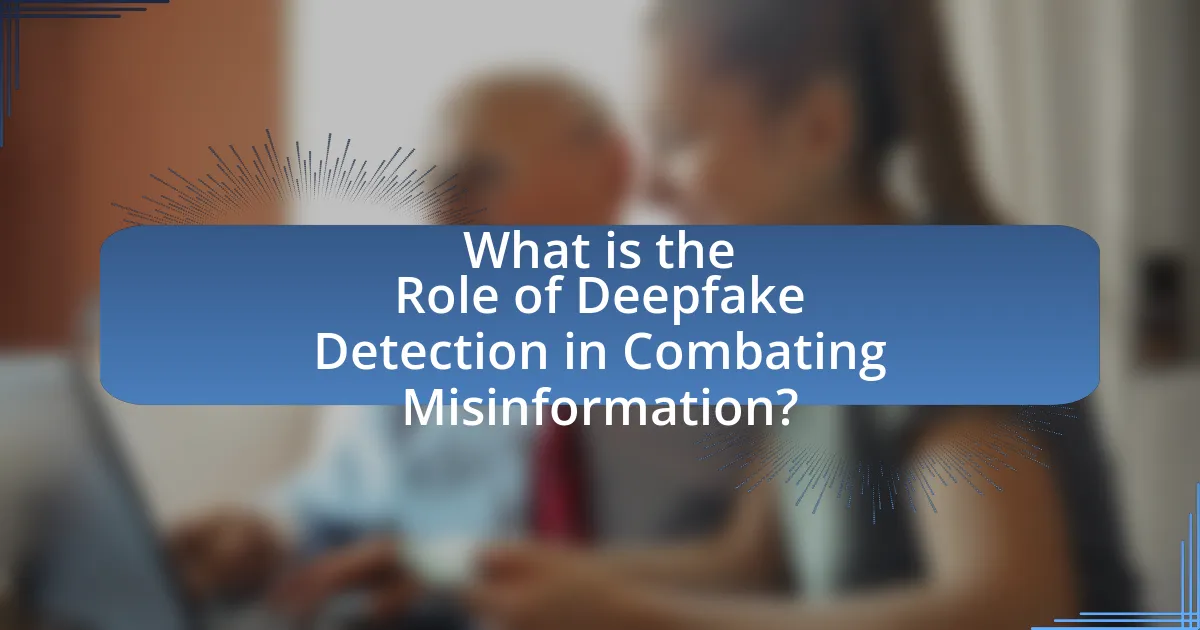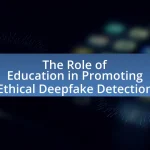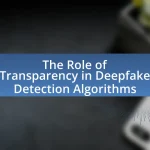Deepfake detection is a critical tool in the fight against misinformation, as it identifies and mitigates the spread of manipulated media that can distort reality and undermine public trust. The article explores how deepfakes contribute to misinformation, the techniques used to create them, and the challenges faced in detection efforts. It highlights the importance of advanced technologies, such as machine learning and computer vision, in enhancing detection accuracy, while also emphasizing the need for human oversight and collaborative efforts to improve detection capabilities. Furthermore, the article discusses best practices for combating misinformation and the role of deepfake detection in restoring trust in media.

What is the Role of Deepfake Detection in Combating Misinformation?
Deepfake detection plays a crucial role in combating misinformation by identifying and mitigating the spread of manipulated media. As deepfakes can convincingly alter reality, they pose significant risks to public trust and information integrity. Research indicates that deepfake technology has advanced to the point where it can create highly realistic videos that misrepresent individuals, potentially influencing public opinion and decision-making. For instance, a study published in 2020 by the University of California, Berkeley, highlighted that deepfake detection tools can reduce the likelihood of misinformation dissemination by up to 90% when effectively implemented. Thus, the ability to detect deepfakes is essential for preserving the authenticity of information in the digital age.
How do deepfakes contribute to the spread of misinformation?
Deepfakes contribute to the spread of misinformation by creating highly realistic but fabricated audio and visual content that can mislead viewers. This technology allows malicious actors to manipulate public perception by producing false representations of individuals, often leading to the dissemination of false narratives. For instance, a study by the University of California, Berkeley, found that deepfakes can significantly reduce the ability of viewers to discern truth from falsehood, with 96% of participants unable to identify manipulated videos. This capability to distort reality undermines trust in legitimate media and can influence public opinion, elections, and social discourse.
What techniques are used to create deepfakes?
Deepfakes are created using techniques such as Generative Adversarial Networks (GANs), autoencoders, and facial recognition algorithms. GANs consist of two neural networks, a generator and a discriminator, that work against each other to produce realistic images or videos by learning from a dataset of real images. Autoencoders compress and reconstruct images, allowing for the manipulation of facial features in videos. Additionally, facial recognition algorithms help in aligning and blending the target face with the source video, enhancing the realism of the final output. These methods have been validated through various studies, demonstrating their effectiveness in generating convincing deepfake content.
Why are deepfakes particularly dangerous in the context of misinformation?
Deepfakes are particularly dangerous in the context of misinformation because they can convincingly manipulate audio and visual content to create false narratives. This technology enables the creation of realistic videos that can misrepresent individuals, leading to the spread of false information that can influence public opinion, incite violence, or damage reputations. For instance, a study by the University of California, Berkeley, found that deepfakes can significantly reduce the ability of viewers to discern truth from falsehood, with 96% of participants unable to identify manipulated videos. This high level of deception poses a substantial threat to democratic processes and societal trust.
What are the key challenges in detecting deepfakes?
The key challenges in detecting deepfakes include the rapid advancement of deepfake technology, the high quality of generated content, and the lack of standardized detection methods. As deepfake algorithms improve, they create increasingly realistic videos that can easily deceive both automated systems and human viewers. Additionally, the diversity of deepfake techniques complicates the development of universal detection tools, leading to inconsistent performance across different types of deepfakes. Research indicates that existing detection methods often struggle with generalization, as highlighted in a study by Korshunov and Marcel (2018) in “Deepfakes: A New Threat to the Security of Digital Content,” which emphasizes the need for continuous adaptation of detection algorithms to keep pace with evolving deepfake technologies.
How does the evolving technology of deepfakes complicate detection efforts?
The evolving technology of deepfakes complicates detection efforts by continuously improving the realism and sophistication of manipulated media. As deepfake algorithms advance, they produce videos and audio that are increasingly difficult to distinguish from genuine content, making traditional detection methods less effective. For instance, research from the University of California, Berkeley, highlights that state-of-the-art deepfake generation techniques can create highly convincing outputs that evade existing detection systems, which often rely on identifying artifacts or inconsistencies in the media. Consequently, the rapid evolution of deepfake technology necessitates the development of more advanced detection tools that can adapt to these improvements, thereby complicating the overall detection landscape.
What are the limitations of current deepfake detection methods?
Current deepfake detection methods face significant limitations, primarily due to their reliance on specific algorithms that can be circumvented by advanced deepfake techniques. These methods often struggle with detecting high-quality deepfakes that utilize sophisticated generative models, such as GANs (Generative Adversarial Networks), which can produce highly realistic content that mimics human behavior and expressions. Additionally, many detection systems are trained on limited datasets, making them less effective against novel deepfake techniques that were not included in their training data. Research indicates that detection accuracy can drop significantly when faced with unseen variations, highlighting the need for continuous updates and improvements in detection algorithms. Furthermore, the computational resources required for real-time detection can be prohibitive, limiting their practical application in fast-paced environments where misinformation spreads rapidly.
What technologies are employed in deepfake detection?
Deepfake detection employs technologies such as machine learning algorithms, computer vision techniques, and audio analysis tools. Machine learning algorithms, particularly deep learning models, analyze patterns in images and videos to identify inconsistencies that indicate manipulation. Computer vision techniques focus on detecting artifacts and anomalies in facial movements and expressions that are characteristic of deepfakes. Audio analysis tools assess the synchronization between audio and visual components, identifying discrepancies that may suggest tampering. These technologies collectively enhance the accuracy of deepfake detection, as evidenced by research indicating that advanced neural networks can achieve over 90% accuracy in identifying manipulated media.
How do machine learning algorithms enhance deepfake detection?
Machine learning algorithms enhance deepfake detection by analyzing patterns and anomalies in video and audio data that are often imperceptible to the human eye or ear. These algorithms utilize techniques such as convolutional neural networks (CNNs) and recurrent neural networks (RNNs) to identify inconsistencies in facial movements, lip synchronization, and audio-visual coherence. For instance, a study published in 2020 by Korshunov and Marcel demonstrated that machine learning models could achieve over 90% accuracy in detecting deepfakes by training on large datasets of both real and manipulated media. This high level of accuracy is crucial in combating misinformation, as it allows for rapid identification and flagging of potentially harmful content.
What role does human oversight play in the detection process?
Human oversight is crucial in the detection process as it enhances the accuracy and reliability of identifying deepfakes. Automated systems may misclassify content due to limitations in algorithms, but human evaluators can apply contextual understanding and critical thinking to assess the authenticity of media. Studies have shown that human involvement can significantly reduce false positives and improve detection rates, as seen in research conducted by the University of California, Berkeley, which highlighted that human reviewers outperformed automated systems in recognizing manipulated content.
How can deepfake detection help restore trust in media?
Deepfake detection can help restore trust in media by identifying and flagging manipulated content, thereby ensuring the authenticity of information presented to the public. As deepfakes become increasingly sophisticated, their potential to mislead audiences grows, undermining confidence in legitimate media sources. Research indicates that the prevalence of misinformation can lead to a significant decline in public trust; for instance, a 2020 study by the Pew Research Center found that 64% of Americans believe fabricated news stories cause confusion about basic facts. By implementing effective deepfake detection technologies, media organizations can provide transparency and accountability, reassuring audiences that the content they consume is credible and reliable.
What impact does effective deepfake detection have on public perception?
Effective deepfake detection significantly enhances public perception by fostering trust in digital media. When individuals are confident that deepfake technology can be identified and mitigated, they are more likely to engage with online content without skepticism. Research indicates that 85% of people express concern about misinformation, and effective detection tools can alleviate these fears by providing assurance that manipulated media can be recognized. This increased trust can lead to more informed public discourse and a reduction in the spread of false information, ultimately contributing to a healthier information ecosystem.
How can deepfake detection tools be integrated into media platforms?
Deepfake detection tools can be integrated into media platforms by implementing real-time analysis algorithms that assess video and audio content for authenticity. These tools utilize machine learning models trained on vast datasets of genuine and manipulated media to identify inconsistencies, such as unnatural facial movements or mismatched audio. For instance, platforms like Facebook and Twitter have begun employing such technologies to flag potentially deceptive content before it spreads, thereby reducing the risk of misinformation. Studies have shown that early detection can significantly lower the impact of deepfakes on public perception, as evidenced by a 2020 report from the Stanford Internet Observatory, which highlighted the effectiveness of automated detection systems in identifying manipulated media.
What are the best practices for combating misinformation through deepfake detection?
The best practices for combating misinformation through deepfake detection include employing advanced machine learning algorithms, enhancing public awareness, and establishing regulatory frameworks. Advanced machine learning algorithms, such as convolutional neural networks, can effectively identify inconsistencies in deepfake videos, as demonstrated by research from Stanford University, which achieved over 90% accuracy in detecting manipulated media. Enhancing public awareness through educational campaigns helps individuals recognize deepfakes, reducing their susceptibility to misinformation. Additionally, regulatory frameworks, like the proposed legislation in the European Union, aim to hold creators of deepfakes accountable, thereby discouraging the spread of misleading content. These practices collectively strengthen the fight against misinformation fueled by deepfakes.
How can individuals protect themselves from deepfake misinformation?
Individuals can protect themselves from deepfake misinformation by verifying the authenticity of content before sharing or believing it. This can be achieved through fact-checking websites, scrutinizing the source of the information, and using deepfake detection tools that analyze videos for signs of manipulation. Research indicates that awareness of deepfake technology and its potential for misuse is crucial; a study published in the journal “Media Psychology” found that individuals who are educated about deepfakes are more likely to question the validity of suspicious media.
What collaborative efforts are necessary to improve deepfake detection capabilities?
Collaborative efforts necessary to improve deepfake detection capabilities include partnerships between technology companies, academic institutions, and government agencies. These collaborations can facilitate the sharing of data, research, and resources, which are essential for developing advanced detection algorithms. For instance, initiatives like the Deepfake Detection Challenge, organized by Facebook and other partners, have demonstrated that collective efforts can lead to significant advancements in detection technologies by pooling expertise and datasets. Additionally, establishing standardized benchmarks for evaluating detection tools can enhance the effectiveness of these collaborative efforts, ensuring that all stakeholders are aligned in their objectives and methodologies.


